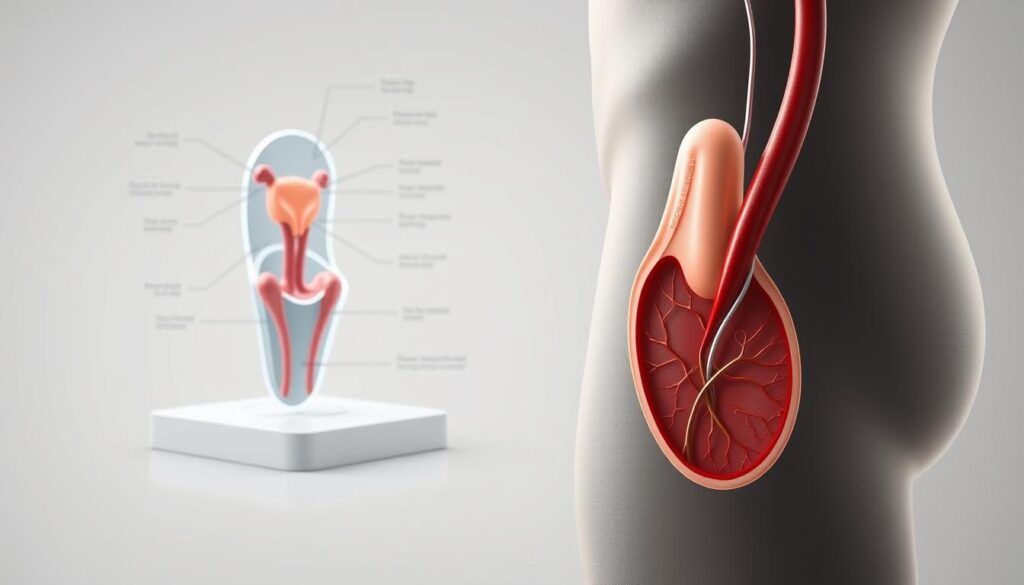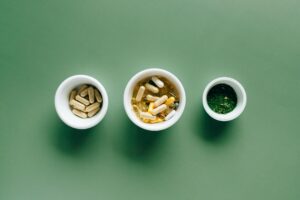Simple Ways to Boost Your Confidence and Improve Erections
Boost your confidence and tackle Erectile dysfunction with our straightforward guide to achieving stronger, healthier erections.

Struggling with performance in the bedroom can shake your confidence. You’re not alone—over half of men aged 40-70 experience challenges at some point. The good news? Solutions exist, and they start with understanding the mind-body connection.
Physical performance is often tied to mental well-being. Stress, anxiety, or low self-esteem can impact your body’s response. This article focuses on evidence-based methods to address both psychological and physiological factors.
From lifestyle tweaks to medical options, we’ll explore practical steps. Small changes in diet, exercise, or mindset can make a big difference. Let’s dive into actionable strategies that work.
Key Takeaways
- Performance issues affect many men but are often treatable
- Confidence plays a key role in physical responses
- Solutions address both mental and physical factors
- Lifestyle changes can significantly improve results
- Medical interventions are available when needed
Understanding Erectile Dysfunction
Many men face challenges with intimacy at some point, often due to physical or mental factors. When these issues persist, they may signal a common condition affecting millions worldwide.

What Is It?
This condition refers to the ongoing inability to achieve or maintain firmness sufficient for intercourse. The Massachusetts Male Aging Study defines it as a persistent problem, not occasional struggles.
“80% of cases stem from physical causes, particularly vascular issues affecting blood flow.”
How Common Is It?
Globally, over 150 million men experienced this in 1995. By 2025, projections suggest 322 million will be affected. Diabetes increases risk—35–50% of diabetic men report symptoms.
| Age Group | Prevalence |
|---|---|
| 40–49 | 5–15% |
| 50–59 | 15–30% |
| 60+ | 20–40% |
Vascular problems often appear years before heart disease diagnoses. This makes early attention crucial for overall health.
Temporary performance issues differ from chronic cases. Stress or fatigue might cause short-term problems, but persistent difficulties often have physical roots.
Physical Causes of Erectile Dysfunction
Your body’s physical health directly impacts performance, often in ways you might not expect. From blood circulation to hormone balance, multiple systems work together. When one falters, it can create a chain reaction.

Cardiovascular and Blood Flow Issues
Arteriosclerosis, or hardened arteries, reduces blood flow where it’s needed most. This isn’t just a heart problem—it’s often an early warning sign. Studies show men with these issues may face bedroom struggles years before other symptoms appear.
A “venous leak” can also occur. Damaged smooth muscles fail to trap blood, causing difficulties. Smoking worsens this by damaging blood vessels further.
Hormonal Imbalances and Diabetes
Half of men with diabetes report performance issues. High blood sugar harms nerves and circulation. Over time, this dual damage makes responsiveness harder.
Low testosterone is another often overlooked cause. Hormones regulate desire and physical responses. Without balance, both suffer.
Medications and Neurological Factors
Over 200 drugs list performance challenges as a side effect. High-risk types include:
- Beta-blockers (for blood pressure)
- SSRIs (antidepressants)
- Chemotherapy drugs
Neurological conditions like Parkinson’s or spinal injuries disrupt signals between the brain and body. Even minor nerve damage can have major effects.
“Medications treat one issue but may create another. Always discuss side effects with your doctor.”
Psychological Factors Affecting Erections
Your mental state plays a bigger role in performance than you might realize. While physical health matters, stress, anxiety, and emotional struggles can disrupt even the strongest bodies. Nearly 25% of cases stem purely from psychological roots.
Stress, Anxiety, and Performance Pressure
Performance anxiety creates a vicious cycle. Worrying about “failing” triggers stress hormones, which then make satisfaction harder. It’s a self-fulfilling prophecy.
Chronic stress elevates cortisol, a hormone that directly interferes with arousal. Past trauma can amplify this, creating invisible barriers. Tip: Focus on intimacy, not perfection.
“Stress floods the body with cortisol, narrowing blood vessels and disrupting the signals needed for performance.”
Depression and Relationship Strains
Depression triples your risk by altering brain chemistry. Low serotonin levels dampen desire and physical responses. Relationship conflicts worsen this—tension breeds distance.
Open dialogue about sex reduces stigma. Partners who tackle challenges together often see faster progress. Remember: situational issues (job loss, grief) differ from chronic depression.
- Psychological causes are treatable with therapy or lifestyle shifts
- Seek help early—avoiding the topic prolongs problems
- Couples counseling rebuilds emotional and physical connections
Lifestyle Changes to Combat ED
Small daily habits can make a big difference in how you feel and perform. Research shows that tweaking your routine improves both confidence and physical responses. Here’s how to start.
Exercise and Cardiovascular Health
30 minutes of daily aerobic exercise boosts performance by 41%. Activities like brisk walking or cycling enhance blood flow and reduce stress. For faster results, try HIIT workouts—they strengthen endothelial cells lining blood vessels.
Even pelvic floor exercises (like Kegels) help. They support muscle control and stamina. Consistency matters more than intensity.
Dietary Adjustments for Better Blood Flow
The Mediterranean diet increases nitric oxide production by 35%. This molecule relaxes blood vessels, improving circulation. Key foods include:
- Beets (rich in nitrates)
- Walnuts (omega-3s reduce inflammation)
- Spinach (high in magnesium)
Limit processed sugars. They spike blood pressure and harm vascular health.
Reducing Alcohol and Quitting Smoking
Alcohol suppresses testosterone, lowering desire and performance. Cutting back restores hormone balance within weeks.
Smoking damages blood vessels, but quitting reverses risk. After 1 year, 25% of men regain full function. Use this timeline:
- 48 hours: Blood pressure normalizes
- 3 months: Circulation improves
- 1 year: Vascular recovery peaks
“Waist size matters—men with >40 inches face higher hormonal imbalances.”
Effective Medical Treatments for ED
Modern medicine offers proven solutions when lifestyle changes aren’t enough. From quick-acting pills to surgical options, treatments today address various causes. Your doctor can recommend the best approach based on your specific needs.
PDE-5 Inhibitors: How They Work
These medications help 70% of men when properly dosed. They enhance blood flow by relaxing smooth muscles. The most common options include:
| Medication | Onset | Duration | Effectiveness |
|---|---|---|---|
| Sildenafil (Viagra) | 30-60 min | 4-6 hours | 82% success rate |
| Tadalafil (Cialis) | 30-45 min | 36 hours | 78% success rate |
Important: Take these only as prescribed. Never mix with nitrates due to dangerous blood pressure drops.
Testosterone Replacement Therapy
This therapy helps only when low testosterone is confirmed. About 10% of cases benefit from TRT. Potential risks include:
- Prostate enlargement
- Increased red blood cell count
- Possible fertility reduction
Regular monitoring ensures safe hormone levels. TRT often combines with other treatments for best results.
Vacuum Pumps and Penile Implants
Non-surgical options include vacuum pump devices. These create erection through controlled suction. Proper technique prevents bruising:
- Apply lubrication to the cylinder
- Place it over the penis
- Pump slowly to create vacuum
- Apply constriction ring at base
For permanent solutions, implants boast 95% satisfaction rates. Modern models allow natural function with quick recovery:
“Most patients resume intimacy 6-8 weeks after surgery with proper care.”
Warning: Avoid counterfeit medications sold online. Only use FDA-approved treatments from licensed pharmacies.
Natural Remedies and Supplements
Nature offers powerful solutions that can support your performance and confidence. Research shows certain supplements and herbs enhance blood flow and stamina. While not replacements for medical treatments, they provide a natural boost when combined with healthy habits.
Evidence-Based Herbal Options
Panax ginseng (red ginseng) stands out in studies. A 2022 review found it improved performance comparably to low-dose Viagra. Look for FDA-approved formulations like Ginsana® for quality assurance.
Horny goat weed (Epimedium) may help, but effects vary. Unlike prescription options, its impact depends on icariin content—aim for 10% standardized extracts.
“Pycnogenol, combined with L-arginine, improved ED scores by 35% in a 3-month trial.”
- Avoid yohimbe: This herb risks rapid heartbeat and anxiety.
- Zinc matters: 30–50mg daily supports testosterone metabolism.
The Role of L-Arginine and Other Nutrients
L-arginine boosts nitric oxide by 40%, enhancing blood flow. Pair it with citrulline (500–1,000mg) for longer-lasting effects. Top food sources include:
- Watermelon (rich in citrulline)
- Pumpkin seeds (high in zinc)
- Dark chocolate (flavonoids aid circulation)
For best results, combine these nutrients with aerobic exercise. Always consult your doctor before starting new supplements, especially if taking blood pressure meds.
Building Confidence Through Communication
Open conversations can transform bedroom struggles into shared solutions. Nearly 40% of partners mistake performance issues for lack of attraction. Breaking this cycle starts with honest dialogue.
How to Talk to Your Partner
Start with empathy. Use “I” statements like, “I feel stressed about this, but we can work together.” Avoid blame—focus on teamwork.
Timing matters. Choose a relaxed moment, not right after intimacy. Sample script:
- “I value our connection and want to improve it.”
- “This isn’t about you—it’s a health challenge we can address.”
“Couples therapy resolves 68% of psychogenic cases by rebuilding trust.”
When to Seek Professional Help
If anxiety persists, cognitive behavioral therapy (CBT) helps. Look for these credentials in a sex therapist:
| Credential | Specialty |
|---|---|
| AASECT | Sexual health certification |
| APA | Psychology expertise |
Cultural barriers? Therapists trained in multicultural care navigate sensitivities. Progressive exposure techniques—like gradual intimacy exercises—reduce fear.
The Link Between ED and Overall Health
Your body sends signals when something’s wrong—performance issues might be one of them. Research shows these challenges often appear years before other health problems surface. Paying attention could help prevent more serious conditions.
Cardiovascular Warning Signs
Performance struggles frequently predict heart disease. The same artery blockages affecting your heart impact blood flow elsewhere first. Studies reveal 70% of coronary events follow performance issues by 3-5 years.
Endothelial dysfunction is the shared mechanism. This lining of blood vessels controls dilation. When damaged, it affects circulation throughout the body. Track these progression markers:
| Time Before Heart Event | Performance Symptoms |
|---|---|
| 5 years | Occasional difficulties |
| 3 years | Frequent challenges |
| 1 year | Consistent struggles |
“Men with performance issues have 58% higher cardiovascular risk—get checked annually.”
Managing Chronic Conditions
Diabetes control directly impacts performance. Every 1% drop in HbA1c levels reduces risk by 15%. Follow these glycemic protocols:
- Test blood sugar 2-4 times daily
- Aim for fasting glucose under 130 mg/dL
- Reduce processed carbs
Blood pressure medications sometimes worsen performance. ACE inhibitors cause fewer issues than beta-blockers. Always discuss alternatives with your doctor.
Treating sleep apnea boosts testosterone by 30% in obese men. CPAP therapy can restore both breathing patterns and performance within months.
Exercises to Strengthen Pelvic Muscles
Targeted exercises go beyond the gym—they can transform intimate health too. Your pelvic muscles act like a hidden support system, affecting everything from posture to performance. A 12-week training regimen improves firmness by 40%, research shows.
Mastering Kegels With Biofeedback
Kegels aren’t just for postpartum recovery. Men benefit equally by strengthening the pubococcygeus (PC) muscle. Try this technique:
- Identify the right muscles (stop urination midstream)
- Contract for 5 seconds, relax for 5
- Use a biofeedback device like Elvie Trainer to track progress
For progressive overload, add resistance bands after 4 weeks. Aim for 3 sets of 10 daily. Tip: Avoid holding your breath—this reduces effectiveness.
Yoga for Circulation and Calm
Yoga cuts cortisol by 27% while enhancing blood flow. These five poses work best for stress reduction and pelvic health:
- Bridge Pose (stimulates pelvic nerves)
- Butterfly Stretch (opens hip flexors)
- Child’s Pose with Kegel pulses
- Happy Baby (massages inner thighs)
- Corpse Pose with diaphragmatic breathing
“Men combining yoga with Kegels saw 50% greater improvement than Kegels alone.”
Wearable tech like the Whoop strap helps monitor progress. Track heart rate variability during sessions—higher numbers signal better recovery.
Navigating Prescriptions and Side Effects
Understanding your medication options helps you make safer, more effective choices. While treatments like PDE5 inhibitors work for most men, side effects and interactions require attention. Here’s how to balance benefits and risk.
Key Precautions for Common Medications
PDE5 inhibitors like Viagra or Cialis improve blood flow but carry warnings. Nitrate interactions—found in heart medications—can cause dangerous blood pressure drops. Always disclose all prescription drugs to your doctor.
| Medication | Half-Life | Contraindications | Common Side Effects |
|---|---|---|---|
| Sildenafil | 4 hours | Nitrates, severe heart disease | Headache (16%), flushing (10%) |
| Tadalafil | 18 hours | Unstable angina | Indigestion (12%), back pain (6%) |
“22% of patients report mild side effects, but severe reactions like priapism require immediate care.”
When to Avoid or Adjust Treatments
Grapefruit juice amplifies side effects by slowing drug metabolism. Skip these medications if you have:
- Severe liver/kidney disease
- Recent stroke or heart attack
- Retinitis pigmentosa (eye condition)
For priapism (erections lasting >4 hours), seek ER care to prevent tissue damage. Cold compresses and light exercise may help while waiting.
Success Stories and Long-Term Strategies
Seeing real results can boost your motivation and commitment to treatment. Nearly 9 in 10 men maintain improvements when combining lifestyle changes with medical support. These victories prove lasting change is possible at any age.
From Diagnosis to Renewed Confidence
Take Michael, a 58-year-old teacher who regained his vitality through systematic changes. His 18-month journey included:
- Cardio workouts 4x weekly
- Mediterranean diet adoption
- Low-dose PDE5 inhibitors initially
- Monthly therapy sessions
“By month six, I felt 15 years younger. Now I focus on maintenance—it’s become part of my health routine.”
Sustaining Your Progress
Create a personalized maintenance plan. The most effective long-term strategies include:
- Quarterly check-ins with your urologist
- Adjusting protocols as you age
- Tracking cardiovascular metrics
- Staying active with pelvic exercises
Implants show remarkable durability—92% satisfaction after 5 years. But non-surgical approaches require more vigilance. Test treatment efficacy annually as your body changes.
Support groups provide accountability. Organizations like Men’s Health Network offer:
- Local meetups
- Online forums
- Educational webinars
- Partner resources
Remember, progress isn’t linear. Temporary setbacks don’t erase your gains. With consistent effort, you can maintain results for decades.
Conclusion
Taking control of your intimate health starts with understanding your options. Challenges like erectile dysfunction are treatable, whether rooted in physical or emotional factors.
Early action matters. Addressing issues promptly improves outcomes and protects overall wellness. Regular check-ups help identify underlying conditions.
Modern treatments—from lifestyle tweaks to medical solutions—offer hope. Your confidence can rebound with the right support.
Consult certified healthcare providers to tailor a plan. You’re not alone, and solutions exist to help you thrive.




